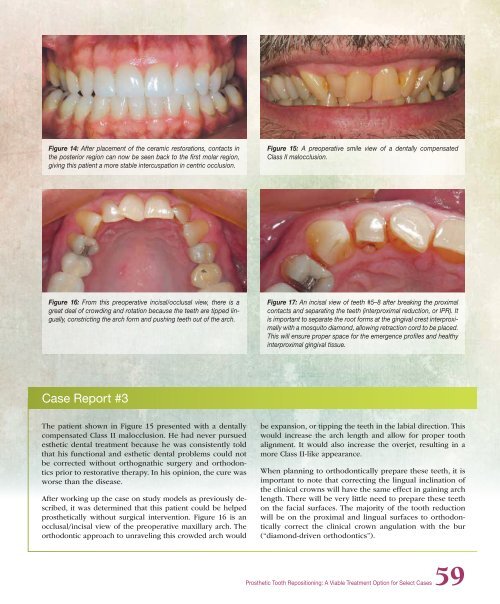PDF Version - Glidewell Dental Labs
PDF Version - Glidewell Dental Labs
PDF Version - Glidewell Dental Labs
Create successful ePaper yourself
Turn your PDF publications into a flip-book with our unique Google optimized e-Paper software.
Figure 14: After placement of the ceramic restorations, contacts in<br />
the posterior region can now be seen back to the first molar region,<br />
giving this patient a more stable intercuspation in centric occlusion.<br />
Figure 15: A preoperative smile view of a dentally compensated<br />
Class II malocclusion.<br />
Figure 16: From this preoperative incisal/occlusal view, there is a<br />
great deal of crowding and rotation because the teeth are tipped lingually,<br />
constricting the arch form and pushing teeth out of the arch.<br />
Figure 17: An incisal view of teeth #5–8 after breaking the proximal<br />
contacts and separating the teeth (interproximal reduction, or IPR). It<br />
is important to separate the root forms at the gingival crest interproximally<br />
with a mosquito diamond, allowing retraction cord to be placed.<br />
This will ensure proper space for the emergence profiles and healthy<br />
interproximal gingival tissue.<br />
Case Report #3<br />
The patient shown in Figure 15 presented with a dentally<br />
compensated Class II malocclusion. He had never pursued<br />
esthetic dental treatment because he was consistently told<br />
that his functional and esthetic dental problems could not<br />
be corrected without orthognathic surgery and orthodontics<br />
prior to restorative therapy. In his opinion, the cure was<br />
worse than the disease.<br />
After working up the case on study models as previously described,<br />
it was determined that this patient could be helped<br />
prosthetically without surgical intervention. Figure 16 is an<br />
occlusal/incisal view of the preoperative maxillary arch. The<br />
orthodontic approach to unraveling this crowded arch would<br />
be expansion, or tipping the teeth in the labial direction. This<br />
would increase the arch length and allow for proper tooth<br />
alignment. It would also increase the overjet, resulting in a<br />
more Class II-like appearance.<br />
When planning to orthodontically prepare these teeth, it is<br />
important to note that correcting the lingual inclination of<br />
the clinical crowns will have the same effect in gaining arch<br />
length. There will be very little need to prepare these teeth<br />
on the facial surfaces. The majority of the tooth reduction<br />
will be on the proximal and lingual surfaces to orthodontically<br />
correct the clinical crown angulation with the bur<br />
(“diamond-driven orthodontics”).<br />
Prosthetic Tooth Repositioning: A Viable Treatment Option for Select Cases59
















